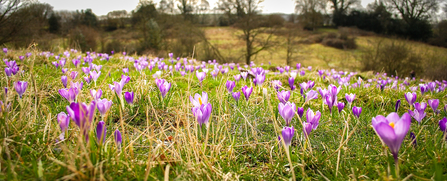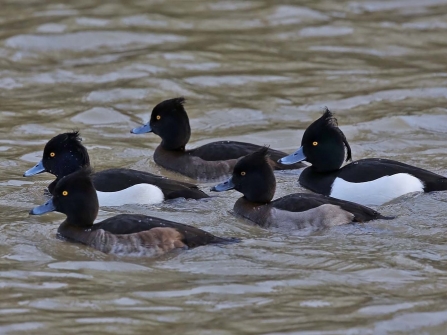
Inkpen Crocus Field. Picture: Adrian Wallington
Inkpen Crocus Field. Picture: Adrian Wallington

Inkpen Crocus Field. Picture: Adrian Wallington
We can never predict exactly when but coming soon is Britain's largest wild display of spring crocuses. From late February to early April, Inkpen Crocus Field in West Berkshire should be awash with the purple and white of more than 400,000 blooms. Keep an eye on our social media channels for the latest news about the crocuses.
One local legend has it that it was the 12th-century Crusaders who brought them back from central Europe. Others believe that they are garden escapees that have established themselves over the last 200 years. Whatever their true origin, the sight is a true spectacle.

Tufted ducks by Margaret Holland
Take a stroll around the lake at the Nature Discovery Centre to look at the waterbirds, pop into the new bird hides and round off your visit with a hot drink in the cafe. There are two new bird hides outside, one overlooking the lake and one overlooking the woodland bird feeders, and a third 'hide in the sky' inside the visitor centre - perfect for those chilly days!
There are lots of events to join at the centre too. Bring the family during half-term for trails, storytelling and more.
If you're looking for some spring flowers for your garden, come along on the weekend of 11 and 12 February for our sale of snowdrops and other flowers.

Singing robin © Neil Aldridge
Tucked away to the north-east of Oxford and packed into a steep valley, Sydlings Copse is a treasure trove for wildlife enthusiasts. The diversity of this small nature reserve is quite staggering. Boasting ancient broadleaved woodland, limestone grasslands, reedbed, fen, and a stream, the reserve supports over 400 plant species.
At this time of year, the woodland is coming alive with birdsong, and colour as flowers start poking through the woodland floor. Escape the busy city for an hour or two and recharge your batteries as you stroll through this peaceful reserve.

A flock of teal at Gallows Bridge Farm, part of the Upper Ray Meadows nature reserve. Photo by BBOWT volunteer Phil Gibbs
Gallows Bridge Farm, part of the vast Upper Ray Meadows nature reserve on the Bucks/Oxon border, is a great spot to visit during the winter months. The site attracts large numbers of ducks, including wigeon and teal, and waders such as lapwing and golden plover.
There is also lots of activity in the hedgerows where birds like goldcrest, bullfinch and siskin will come to feed. Look out for large flocks of redwing and fieldfare, too and keep an eye open for hunting raptors including kestrel and peregrine.
The seasonal hide is open at this time of year and has good views of the scrapes and pools in the main meadow where you can see plenty of different birds.

Brown hare by Mark Hamblin/2020VISION
Look out for hares in the fields at Wells Farm. Some are even starting to 'box', a sure sign that spring is on its way. Retained winter stubble and seed-bearing crops provide food and shelter for mixed flocks of finches in the colder months. The hedges are full of birds too including redwing and fieldfare feeding on the berries.
This is a working farm that's run in harmony with nature, demonstrating how farms can be a thriving habitat for wildlife. Be aware that there is a lot of livestock on site at the moment so make sure dogs are under close control and preferably on a lead.

This area has been wooded since at least 1600. The nature reserve has undergone many changes in recent years. More than half of the wood was felled and replanted with conifers in the 1960s. Now, the large area of densely planted conifers is being slowly removed so the wood can return to majestic, native broadleaved woodland. Cleared areas are already softening with oak, ash, birch, willow, hawthorn and wild flowers.
Listen out for birds in the wood as you stroll the paths and look out for early spring flowers starting to bloom.